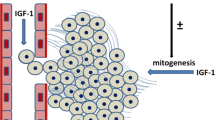Abstract
We demonstrate the expression of angiotensin II type 1 (AT1) receptors in normal and diseased human breast tissues. Using monoclonal antibody 6313/G2, directed against a specific sequence in the extracellular domain of the AT1 receptor, immunocytochemical analysis revealed positive immunoreactivity in membrane and cytoplasm of specific cell types. Immunoblotting of solubilized proteins separated by sodium dodecyl sulphate polyacrylamide gel electrophoresis (SDS-PAGE) from benign and malignant tumours identified a single immunoreactive species with a molecular mass of approximately 60 kDa, consistent with that of the mature glycosylated receptor. In studies of [125I]angiotensin II binding using breast membrane preparations, concentrations of specific angiotensin II binding sites were found to range from 1.8 to 100 fmol mg(-1) protein, with a K(d) of approximately 60 nM. Most of the specifically bound [125I]angiotensin II was displaced by losartan, a specific angiotensin II type 1 receptor antagonist, while less was displaced by the AT2 receptor type antagonist, CGP42112A, thus confirming the prevalence of AT1 receptors in this tissue type. These data suggest that the renin-angiotensin system may be involved in normal and abnormal breast tissue function.
Similar content being viewed by others
Author information
Authors and Affiliations
Rights and permissions
About this article
Cite this article
Inwang, E., Puddefoot, J., Brown, C. et al. Angiotensin II type 1 receptor expression in human breast tissues. Br J Cancer 75, 1279–1283 (1997). https://doi.org/10.1038/bjc.1997.217
Issue Date:
DOI: https://doi.org/10.1038/bjc.1997.217
- Springer Nature Limited
This article is cited by
-
The renin-angiotensin-aldosterone system (RAAS) signaling pathways and cancer: foes versus allies
Cancer Cell International (2023)
-
Angiotensin II promotes ovarian cancer spheroid formation and metastasis by upregulation of lipid desaturation and suppression of endoplasmic reticulum stress
Journal of Experimental & Clinical Cancer Research (2019)
-
Angiotensin II Type 1 Receptor (AT-1R) Expression Correlates with VEGF-A and VEGF-D Expression in Invasive Ductal Breast Cancer
Pathology & Oncology Research (2012)
-
Effect of AT1R knockdown on ishikawa cell proliferation induced by estrogen
Archives of Gynecology and Obstetrics (2012)
-
Mammary renin–angiotensin system-regulating aminopeptidase activities are modified in rats with breast cancer
Tumor Biology (2010)




